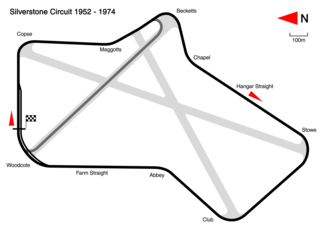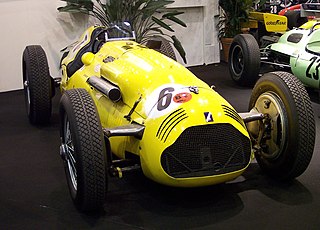
The 1952 French Grand Prix was a Formula Two race held on 6 July 1952 at Rouen-Les-Essarts. It was race 4 of 8 in the 1952 World Championship of Drivers, in which each Grand Prix was run to Formula Two rules rather than the Formula One regulations normally used. Unusually this race was run over a duration of 3 hours, rather than a fixed distance.

The 1952 British Grand Prix was a Formula Two race held on 19 July 1952 at Silverstone Circuit. It was race 5 of 8 in the 1952 World Championship of Drivers, in which each Grand Prix was run to Formula Two rules rather than the Formula One regulations normally used.

The 1952 Dutch Grand Prix was a Formula Two race held on 17 August 1952 at the Circuit Zandvoort. It was race 7 of 8 in the 1952 World Championship of Drivers, in which each Grand Prix was run to Formula Two rules rather than the Formula One regulations normally used. The 90-lap race was won by Ferrari driver Alberto Ascari after he started from pole position. His teammates Giuseppe Farina and Luigi Villoresi finished in second and third places. Ascari overtook Fangio's record for the most race wins, scoring his seventh at this race.

Henry O'Reilly "Harry" Schell was an American Grand Prix motor racing driver. He was the first American driver to start a Formula One Grand Prix.
Christian Roger Xavier Marie Joseph Ghislain Goethals was a racing driver from Belgium. Goethals competed as an amateur in sports car races, driving a Porsche Spyder during the 1950s. His best results were a second-place finish with his brother in the 1956 1500cc class event in Reims, and a win in the same class the following year at Forez. Goethals acquired a Cooper-Climax and entered it in the Formula Two class of the 1958 German Grand Prix, but retired from the race. He did not participate in another Formula One Grand Prix, and returned to sports cars, with notable finishes in 1960 of fifth in the Buenos Aires 1000 km and second in the GP de Spa. He retired from racing later in the season. He established a racing team called Écurie Éperon d'Or to participate in the 1958 German Grand Prix where he raced in a Cooper T43.

Heinz Schiller, was a racing driver from Switzerland. He participated in one Formula One World Championship Grand Prix, on August 5, 1962. He retired from the race, scoring no championship points.

Jacques Swaters was a racing driver from Belgium and former team owner of Ecurie Francorchamps and Ecurie Nationale Belge.

Octave John Claes was an English-born racing driver who competed for Belgium. Before his fame as a racing driver, Claes was also a jazz trumpeter and successful bandleader in Britain.

Lucien Bianchi, born Luciano Bianchi, was an Italian born Belgian racing driver who raced for the Cooper, ENB, UDT Laystall and Scuderia Centro Sud teams in Formula One. He entered a total of 19 Formula One World Championship races, scoring six points and had a best finish of third at the 1968 Monaco Grand Prix.
Jack Fairman was a British racing driver from England. He participated in 13 Formula One Grands Prix, making his debut on 18 July 1953. He scored a total of five championship points, all of which came in the 1956 season.
Alain Carpentier de Changy was a racing driver from Belgium. His single Formula One World Championship Grand Prix attempt was at the 1959 Monaco Grand Prix with a Cooper run by Ecurie Nationale Belge, but he failed to qualify. He was more successful in sports car racing.

Robert Michael Doornbos is a Dutch former racing driver who also competed with a Monégasque licence. He has been test and third driver for the Jordan and Red Bull Racing Formula One teams, as well as driving for Minardi and Red Bull Racing in 2005 and 2006. Doornbos then drove for Minardi Team USA in the 2007 and final season of the Champ Car World Series. He competed in the Superleague Formula racing series in 2008, and drove for the Netherlands team in A1 Grand Prix's 2008–2009 season. In 2009, Doornbos competed in the IndyCar Series. He began the season with Newman/Haas/Lanigan Racing, but switched to HVM Racing after the race in Kentucky Speedway.
Ecurie Francorchamps was a Belgian motor racing team. They are principally known for running privateer cars in Formula One and sports car racing during the 1950s and 1970s. The team was founded by racing driver Jacques Swaters. Between 1952 and 1954 Ecurie Francorchamps raced in Formula One, and raced in sports cars into the 1970s.

Ecurie Ecosse was a motor racing team from Edinburgh, Scotland. The team was founded in November 1951 by Edinburgh businessman and racing driver David Murray and mechanic Wilkie Wilkinson. Its most notable achievement was winning the 1956 and the 1957 24 Hours of Le Mans. The team also raced in three Formula One races. Ecurie Ecosse's cars were always distinctive in their flag blue metallic paint.

The Cooper T51 was a Formula One and Formula Two racing car designed by Owen Maddock and built by the Cooper Car Company for the 1959 Formula One season. The T51 earned a significant place in motor racing history when Jack Brabham drove the car to become the first driver to win the World Championship of Drivers with an engine mounted behind them, in 1959. The T51 was raced in several configurations by various entrants until 1963 and in all no less than 38 drivers were entered to drive T51s in Grand Prix races.
Ecurie Rosier and Equipe Rosier were names used by French racing driver Louis Rosier to enter his own cars in Formula One between 1950 and his death in 1956. Commonly the vehicles were entered for Rosier himself, but he also provided cars for a number of other drivers during the period. Between 1950 and 1957 Ecurie Rosier collected a total fifteen World Championship points and one podium finish.

Ecurie Bonnier, Ecurie Suisse, Joakim Bonnier Racing Team and Anglo-Suisse Racing Team were names used by Swedish racing driver Joakim Bonnier to enter his own cars in Formula One, Formula Two and sports car racing between 1957 and his death in 1972. Commonly the vehicles were entered for Bonnier himself, but he also provided cars for a number of other drivers during the period.
Jacques Coune (1924-2012) was a Belgian coach builder who designed and built a variety of specials via his company Carrosserie Jacques Coune, and was a co-founder of the Ecurie Nationale Belge F1 team.











